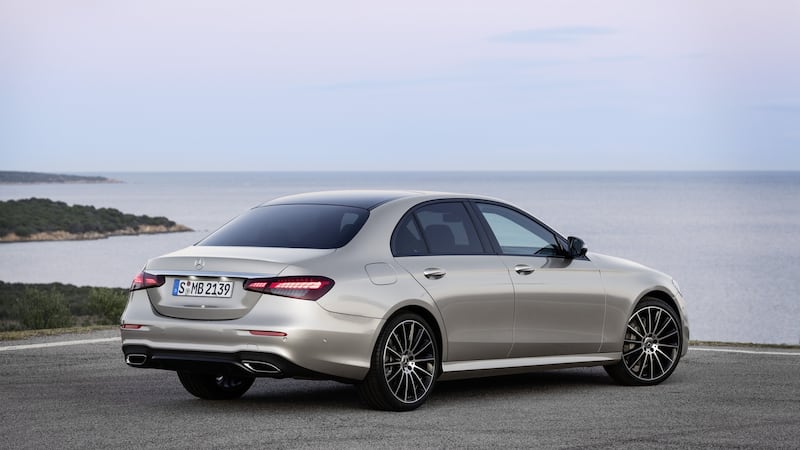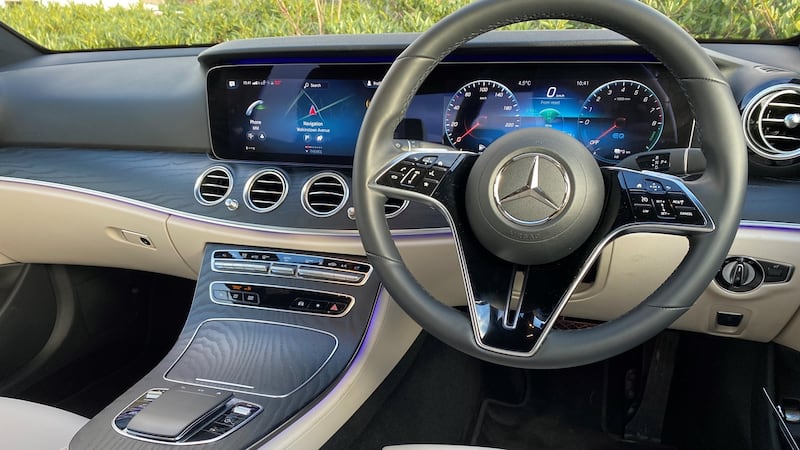If you fancy a hybrid with a plug then it’s probably time to get a move on. The Government has announced that it is trimming grants for buyers of plugin-hybrid electric vehicles (PHEVs) from July 1st. From that date, the current grant, given by the Sustainable Energy Authority of Ireland, will be cut from €5,000 to €2,500.
Will it severely hit orders for Mercedes’ E-Class PHEV? The company’s Irish executives seem a little irked, warning us that “the risk inherent in the removal of incentives is that it will likely have an adverse affect opposite to what the intention might have been”.
Yet I still don’t think it will deter many buyers. People who have money generally don’t like to give it away, but, equally, they’re unlikely to swap the Merc badge for something more mainstream for the sake of €2,500.
As with all plug-in hybrids, hit the motorway and the engine plays a bigger role in the show. But then that leaves you with old-school fuel economy figures
As we were testing this E-Class, engineers at Mercedes were revealing details of the plug-in hybrid version of its new smaller C-Class, promising a full-electric range of 100km before the engine ever has to join in the effort.
And last week Mercedes unveiled its new all-electric luxury saloon, the EQS, promising a full-electric range of up to 770km between charges. That's surely enough to put an end to range issues for even the most anxiety-prone electric motorist.
All these triple digits makes the E-Class PHEV’s electric range of about 50km look positively mundane. But in reality that’s fine for most commuters, and the support of the 2-litre petrol engine under the bonnet means the combined range exceeds 600km with a full tank and the battery charged.
As with all these plug-in hybrids, hit the motorway and the engine plays a bigger role in the show. But then that leaves you with old-school fuel-economy figures.
Whatever about the official claims, the on-board computer estimated our full electric range as between 27km and 35km or so after most charges, which isn't bad for most commuters. It meant the engine did do some work on longer trips, and that's where fuel economy went to 4.4l/100km (or 64.2mpg in old money). That's not going to make Elon Musk choke on his Soylent shake.

What you get here is not so much a vision of the new electric age as a glimpse of its dawn. In reality the 50km range varies depending on what sort of speeds you are doing and, frankly, who is behind the wheel. Someone with several thousand miles of regular hybrid driving will muster high double and even triple miles per gallon in old money. Others with lead boots will draw on the engine a lot more and, in turn, gripe about the relatively low electric range.
If you are part of the latter crew, then it’s easy to argue that a PHEV is not for you; most of the time you’ll simply be hauling a hefty battery pack around the country, and, frankly, there are more engaging companions to car-share with. The same goes if you don’t bother to plug it in: then you’d be far better with a regular diesel.
So PHEVs are not for everyone. Not everyone is lucky enough to have private off-street parking, where they can avail of a home charger, but if you do, and if your regular commute is in the region of 50km or so, then this is a great way to make the move to electric. When the charge from the plug runs out, the battery then operates on the same basis as a regular hybrid, picking up its charge when you coast or brake. That’s enough to give the frugal driver several more electric kilometres before they get to plug it in again.
Excuse this quick diversion to answer a question most of you probably already know, but I’ve been asked this question once too often to ignore it: does the driver have to switch between electric and engine mode? No, the car’s management system looks after all this, and it’s often this feature that defines a hybrid. Frugal-minded models are tuned to maximise economy, so that often means throttles that deter acceleration and engine’s that sound in absolute agony when put under pressure. Others models are more obliging to the more enthusiastic motorist.

This Mercedes, thankfully, doesn’t try to curb your enthusiasm. The E300e can deliver the fuel-sipping hybrid experience if that’s your game, but find yourself in a rush on the motorway or needing to overtake a line of tractors on a national route and it hunkers down and gets on with the job in much the same way the non-hybrid E-Class models do.
And there’s plenty of performance kick to call upon, with a whopping 700Nm of torque on tap, the sort of figure that would put many big diesels to shame. A 0-100km/h time of 5.7 seconds makes a proper performance saloon.
In terms of the more regular fare, like ride and handling, the E-Class still has the edge on rivals, with sharper steering an added bonus. This mid-life upgrade also sees the introduction of the firm’s ne MBUX infotainment system that delivers a swathe of touchscreens across the dash with sharp graphics and impressively quick responses.
The ultimate accolade for Mercedes tech heads and interior designers is that this cabin is a comfortable place to be when you’re travelling.
And you can arrive with a relatively clearer conscience, knowing that with emissions of 38g/km, you’ve made a decent dent in your carbon footprint.
Lowdown: Mercedes E300e PHEV
Power: 1,991cc 208bhp petrol engine combining with an electric motor powered by a 13.5kWh battery pack to deliver 320bhp and 700Nm of torque matched to a nine-speed automatic transmission
0-100km/h: 5.7 secs
L/100km (mpg): 1.8 l/100km (157mpg)
WLTP Emissions (motor tax): 37/g/km (€140)
Price: €60,825
Verdict: Still the king of the executive saloons and now with a cleaner conscience












